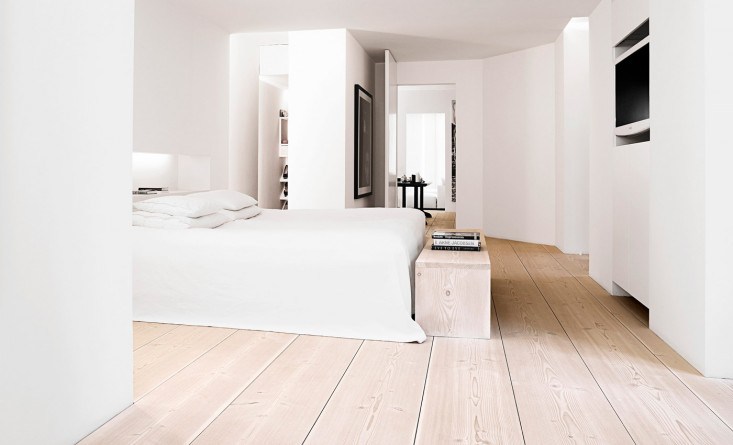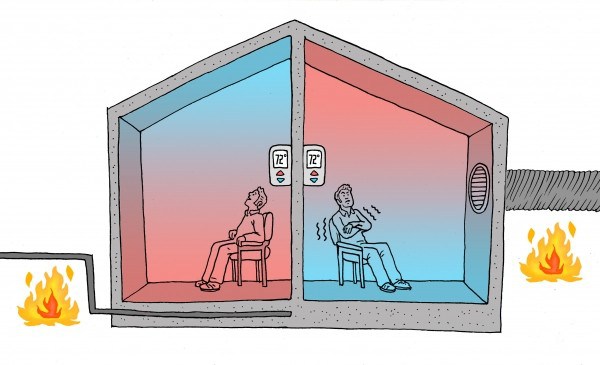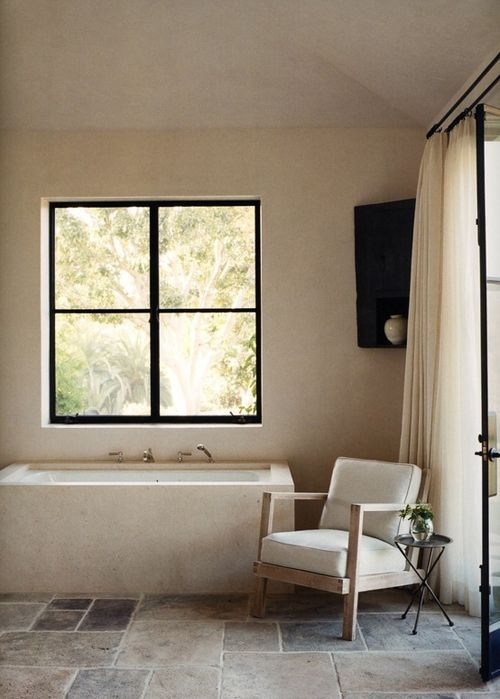Remodeling 101: 5 Things to Know About Radiant Floor Heating by
Can anyone resist the sensation of walking barefoot on a heated floor? If you’re just embarking on a renovation or building a new house, consider installing radiant heating (also known as underfloor heating), an energy-efficient way to keep warm throughout the cold months. As an architect who has supervised and survived many remodels, I have experienced radiant floor heating in other people’s houses and covet it in my own. Here’s the lowdown on the subject: Read on if you’re ready to rip up your floors in the name of cost-effective, energy-efficient heat.
1. What is radiant floor heating?
Invented by the engineering-savvy ancient Romans, who had slaves fanning wood-burning fires under elevated marble floors, radiant floor heating is an under-the-floor heating system that conducts heat through the floor surface rather than through the air (as in conventional forced-air heating systems).

Above: Imagine waking up and putting your bare feet on warm oak floorboards every morning in the winter. Photograph via Dinesen.
2. How does radiant floor heating work?
The two most common types of radiant-floor heating systems are electric (heat via electric wires) and hydronic (heat via hot water tubes), both of which are buried underneath the floor. Here’s how the two compare: Electric radiant-floor heating systems are easier and more affordable to install, but more expensive to operate, making them ideal for heating small areas. Hydronic systems are less expensive to operate, so they work well for large floor areas and even entire houses. The caveat is that they come with higher initial costs because they’re more complicated to install and require heated water from a boiler or a water heater. For more on the pros and cons of each system and which might be better suited to you, see Radiant Floor Heating: Electric vs. Hydronic by San Francisco contractor Jeff King of Jeff King & Company, a member of the Remodelista Architect and Designer Directory.

Above L: An electric wire system being installed in a bathroom. Photograph via Maud Plantiga on Flickr. Above R: A hydronic system waiting for the flooring to be installed. Photograph via Triangle Tube.
3. What are the pros of radiant floor heating?
Not only does radiant floor heating keep your toes warm, but it ensures that the rest of your body will be kept at a comfortable temperature as well. Waves of infrared radiation rising from the floor warm up the building mass, insuring that heat isn’t lost to surrounding surfaces. In a conventional forced-air heating system, heated air (along with dust and allergens) rises to the ceiling and drops back down as its temperature lowers, making it difficult to keep your toes warm even if everything above your shoulders is boiling. “We experience pure warmth with radiant floor heating. As we heat up from our feet, we stay warmer at a lower temperature,” says contractor Jeff King. Delivering heat and comfort efficiently, what’s not to love?

Above: The diagram on the left illustrates the principle of radiant floor heating in which heated surfaces transmit heat to all surrounding objects. There is no loss of heat because everything is at the same temperature. The diagram on the right illustrates how heated air in a conventional forced-air system rises to the ceiling and then comes back down as cool air. This explains how you can still be cold when the thermostat says 72 degrees. Diagram via Sustainability Workshop.
4. What are the cons of radiant floor heating?
A radiant-floor heating system is difficult to install after a floor is already in place, and it’s really only feasible if you’re prepared to remove your floors or are building a new house. While there are new products, such as electric radiant pads, that can be installed between the joists underneath your floor, they require access from below via a basement or crawl space. Lack of one or the other is a deal breaker.

Above: Stone tiles work well with radiant floor heating because of the material’s thermal conducting properties. Shown here, rough-hewn stone tiles in a bathroom by Atelier Am of Los Angeles. Photograph via Mark D. Sikes.
5. Which flooring materials work best with radiant heat?
While all flooring materials can be used with heated floors, some work more effectively than others. Some general rules of thumb: Materials with thermal-conducting properties (stone, concrete, ceramic tile) conduct, transfer, and hold heat effectively while withstanding high temperatures. Solid wood floors can shrink and expand with fluctuating temperatures leaving unsightly gaps. If you’re in love with wood floors, however, an experienced wood-floor installer will be able to manage potential shrinkage. Vinyl and plastic laminate floors also come with temperature limitations, while carpets have insulating properties that potentially reduce heat flow.

Above: Polished concrete floors with radiant floor heating warm a house converted from a horse stable by AR Design Studio. See Manor House Stables, A Champion’s Home Reborn for more. Photograph via AR Design Studio.




